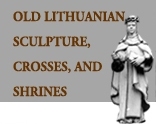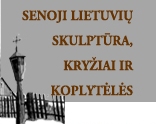Traditional Lithuanian folk
sculpture: from the collections
of Lithuanian Art Museum
From
LIAUDIES
KULTURA. 1995 m. No. 1
Akvile Mikenaite
Traditional Lithuanian folk sculpture called small idols,
statuettes is a branch of the visual arts and takes
an important place in Lithuanian folk art. It was widely spread in Lithuania
in the nineteenth  century
and in the beginning of the twentieth century. It remained
up to now in Zemaitija (Samogitia) upon a large scale. The oldest examples
of the sculpture are known from the end of the eighteenth century and the
beginning of the nineteenth century. There are two different approaches as
far as the origin of Lithuanian folk sculpture is concerned. Some
investigators think that there had not been any gods in the form of idols
worshiped by Lithuanians. Thus, folk sculpture is the
result of Christianity. The opposite opinion is that Lithuanian folk
sculpture is the result of paganism. P. Galaune and M. Vorobjovas were the
first who evaluated statuettes as works of art. The choise of shrine
makers' themes was set by historical conditions. Christian iconography was
understood by a folk artist in his own way and it was interpreted according
to his own perception, thinking and experiences. The culture inherited from
our ancestors is related to the transformations of Christianity. The themes
chosen were close to peasents' life and their experiences. Special attention
was paid to the worship of Christ and St. Maria in Lithuania. St. John
Nepomucene, St. John Chrysostom, St. Isidore, St. George, St. Casimir, St.
Francis, Si Roch, St. Agatha, St. Catherine and others spread over all
Lithuania. The theme of the mourning Christ (Rupintojelis) was wery close to
Lithuania. Traditional Lithuanian folk sculpture is the top of Lithuanian
shrine makers' creative work.
century
and in the beginning of the twentieth century. It remained
up to now in Zemaitija (Samogitia) upon a large scale. The oldest examples
of the sculpture are known from the end of the eighteenth century and the
beginning of the nineteenth century. There are two different approaches as
far as the origin of Lithuanian folk sculpture is concerned. Some
investigators think that there had not been any gods in the form of idols
worshiped by Lithuanians. Thus, folk sculpture is the
result of Christianity. The opposite opinion is that Lithuanian folk
sculpture is the result of paganism. P. Galaune and M. Vorobjovas were the
first who evaluated statuettes as works of art. The choise of shrine
makers' themes was set by historical conditions. Christian iconography was
understood by a folk artist in his own way and it was interpreted according
to his own perception, thinking and experiences. The culture inherited from
our ancestors is related to the transformations of Christianity. The themes
chosen were close to peasents' life and their experiences. Special attention
was paid to the worship of Christ and St. Maria in Lithuania. St. John
Nepomucene, St. John Chrysostom, St. Isidore, St. George, St. Casimir, St.
Francis, Si Roch, St. Agatha, St. Catherine and others spread over all
Lithuania. The theme of the mourning Christ (Rupintojelis) was wery close to
Lithuania. Traditional Lithuanian folk sculpture is the top of Lithuanian
shrine makers' creative work.

